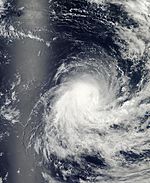2002–03 South-West Indian Ocean cyclone season
| 2002–03 South-West Indian Ocean cyclone season |

Season summary map
|
| Seasonal boundaries |
| First system formed |
September 5, 2002 |
| Last system dissipated |
May 13, 2003 |
| Strongest storm |
|
| Name |
Kalunde |
| • Maximum winds |
215 km/h (130 mph)
(10-minute sustained) |
| • Lowest pressure |
910 hPa (mbar) |
| Seasonal statistics |
| Total disturbances |
14 |
| Total storms |
12 tropical, 1 subtropical |
| Tropical cyclones |
7 |
| Intense tropical cyclones |
3 |
| Total fatalities |
168 |
| Total damage |
$3.16 million (2003 USD) |
| Related articles |
|
|
South-West Indian Ocean tropical cyclone seasons
2000–01, 2001–02, 2002–03, 2003–04, 2004–05
|
| Moderate tropical storm (MFR) |
| Tropical storm (SSHWS) |
|
|
| Duration |
September 5 – September 8 |
| Peak intensity |
65 km/h (40 mph) (10-min) 1003 hPa (mbar) |
| Tropical depression (MFR) |
| Tropical storm (SSHWS) |
|
|
| Duration |
November 4 – November 13 |
| Peak intensity |
55 km/h (35 mph) (10-min) 997 hPa (mbar) |
| Tropical cyclone (MFR) |
| Category 1 tropical cyclone (SSHWS) |
|
|
| Duration |
November 14 – November 27 |
| Peak intensity |
130 km/h (80 mph) (10-min) 965 hPa (mbar) |
| Tropical cyclone (MFR) |
| Category 2 tropical cyclone (SSHWS) |
|
|
| Duration |
December 21 – December 29 |
| Peak intensity |
150 km/h (90 mph) (10-min) 955 hPa (mbar) |
| Severe tropical storm (MFR) |
| Tropical storm (SSHWS) |
|
|
| Duration |
December 30 – January 9 |
| Peak intensity |
95 km/h (60 mph) (10-min) 985 hPa (mbar) |
| Severe tropical storm (MFR) |
| Category 1 tropical cyclone (SSHWS) |
|
|
| Duration |
January 7 – January 12 |
| Peak intensity |
115 km/h (75 mph) (10-min) 972 hPa (mbar) |
| Severe tropical storm (MFR) |
| Tropical storm (SSHWS) |
|
|
| Duration |
January 24 – January 31 |
| Peak intensity |
95 km/h (60 mph) (10-min) 985 hPa (mbar) |
| Intense tropical cyclone (MFR) |
| Category 3 tropical cyclone (SSHWS) |
|
|
| Duration |
February 5 – February 15 |
| Peak intensity |
165 km/h (105 mph) (10-min) 940 hPa (mbar) |
| Tropical cyclone (MFR) |
| Category 2 tropical cyclone (SSHWS) |
|
|
| Duration |
February 7 – February 16 |
| Peak intensity |
150 km/h (90 mph) (10-min) 960 hPa (mbar) |
The 2002–03 South-West Indian Ocean cyclone season was one of the longest lasting and the second-most active season in the South-West Indian Ocean. Storms during the season impacted the Mascarene Islands, Seychelles, Madagascar, and countries in southeastern Africa. The season began early when an unnamed tropical storm struck Seychelles in September, becoming the most damaging storm there in 50 years. The next system, Atang, was the first named storm of the season, but was only a tropical depression; it was named due to the threat to an outer island of Mauritius. Atang later struck Tanzania in a climatologically unusual area in November, resulting in unconfirmed deaths of fishermen. The first named storm to reach tropical storm intensity was Boura, which brushed the Mascarene Islands with gusty winds and rainfall. In December, Cyclone Crystal threatened to strike Mauritius but instead veered eastward, and later, Tropical Storm Delfina lasted from late December through early January 2003. Delfina damaged or destroyed thousands of houses in Mozambique and Malawi, killing 54 people.
In January 2003, Severe Tropical Storm Ebula continued the steady activity, forming in the eastern portion of the basin. Later, Tropical Storm Fari crossed southern Madagascar with heavy rains, causing flooding and mudslides that left 3,400 people homeless. In February, there were four simultaneous tropical cyclones in the Indian Ocean, three of which in the basin. Cyclone Gerry formed first and the farthest west, passing just east of Mauritius and killing one person there. Cyclone Hape formed shortly thereafter, and Tropical Storm Isha formed farther east, having originated from the Australian basin. Cyclone Japhet struck southern Mozambique and produced widespread flooding in southeastern Africa, killing 25 people. In March, Cyclone Kalunde was the strongest storm of the season, reaching 10-minute sustained winds of 215 km/h (135 mph). It struck Rodrigues while weakening, damaging 1,600 houses and causing an island-wide power outage. About a month later, a subtropical cyclone named Luma intensified southeast of Madagascar and developed an eye. Lastly, Cyclone Manou was only the sixth May tropical cyclones on record, making a rare landfall in southeastern Madagascar, killing 89 people and destroying thousands of houses.
...
Wikipedia



















